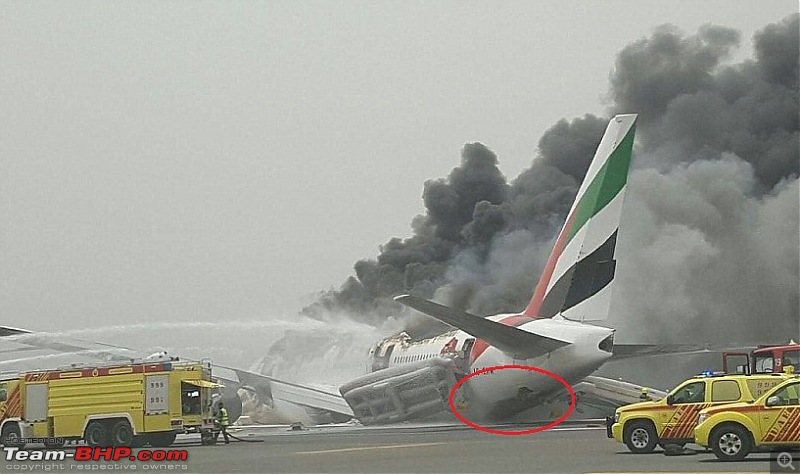
 |
|
Originally Posted by honeybee
(Post 4030048)
Maybe like the central locking in cars, planes should have overhead bin locking the moment they start moving. |
|
Originally Posted by searchingheaven
(Post 4029716)
The difference between the THR and THR REF would be small, like 5% or so. But, maybe, just maybe, this combined with the engine transient time made the all the difference between the aircraft climbing and falling flat in 50 degree heat. Regarding the FD being not active, I don't think there's any possibility of that happening. Disregarded maybe, but not active is not probable. PS: I have heard rumors that temperatures are underreported in UAE. Thing is, if temperature rises above 50 degrees, all construction activities involving manual labor is stopped. So agencies regularly report lower temperatures than actual. Of course engines don't work on underreported temperatures. But I don't know if this is correct. Can RVD confirm? He flies Dubai sectors frequently. |
|
Originally Posted by RVD
(Post 4030146)
I have my doubts about the theory of the aircraft performance being a factor.Surely, they would have discussed the approach climb gradients during their briefing. Could you look up your QRH and share at what temperature does the aircraft becomes approach climb limited ? Regarding the temperatures being under reported, I believe that it is done for the reason stated by you. I cannot confirm myself as all our operations to Dubai are usually in the mornings or evenings. I had actually departed that day from Abu Dhabi at 8AM local time and the temperature was already 37 Degrees. Ps : Does the 777 have a stick pusher ?? Thanks |
|
Originally Posted by RVD
(Post 4030146)
I have my doubts about the theory of the aircraft performance being a factor.Surely, they would have discussed the approach climb gradients during their briefing. Could you look up your QRH and share at what temperature does the aircraft becomes approach climb limited ? |
|
Originally Posted by honeybee
(Post 4030150)
I think the newspapers today reported it was due to wind shear (not the same term used but I think it means the same thing). So can the experts throw some light on what is wind shear? |
|
Originally Posted by honeybee
(Post 4030345)
Does anyone have any idea why the crew wanted to go around? |
| Yesterday was the hot day for DXB, temperature was 48°C and QNH was 994. 12L was for arrival and 12R for departure. We (IX-384) were at E2, and we taxied out via P2 and holding at N2 to cross 12L after the arriving aircraft. We saw our A321 PPB or E coming in, and at around 200 feet becoming unstable. Her attitude & wings went up down and immediately she went around. As advised, we cross the runway and proceeded to M2 L3 for further taxi. After that A321, another Emirates' 777 went around. Both the birds did go-around, around 200 feet, so I guess the winds at that height were unfavourable. We continued our taxi on L4, briefly held at L4B, took a left turn at K for K4 intersection departure. During this time and after those two go arounds, we saw one more EK 777 landing on the runway 12L. We were on Kilo so couldn't see her approach, but we saw her landing at the normal touchdown zone. When we were turning left on Kilo for K4 departure, and after completion of our checks, we saw her - EK521. They were sightly ahead of the perpendicular position on 12L - with respect to K4 of 12R. She was about 30/40' from the ground with nose up attitude, her attitude confused us thinking if ATC allowed parallel take off from 12L. We were discussing this, and we saw she is struggling to climb (landing dear were down). At a point around 150/200 feet, the struggle to climb stopped, for s brief moment leveled out, and then slowly she came down. Those chain of events: from 50' feet, to level out, and coming down, looked like a slow motion for me. May be because of the unusual that happened, or, because of the thrust versus weight struggle, or, my perception - I don't know. But that was unreal for me to see 777 struggling and then succumbing to engines' fight with temperature + pressure. Pilots went around (very low height) post windshear alert and so didn't take the gear up as per the required actions, OR, deliberately left the gear down following a normal go around and would have realised that rate of climb is insufficient. Whatever is the reason - but their decision of keeping the gear down was indeed a remarkable decision. IMO, a boon for all of them. I wish, media won't put the blame again for "Pilot's Error", and shall appreciate their reflexive actions. I guess the happenings after she came down, you all know. We were stuck inside the AXI for more than three hours, were at airport until evening, had brief rest, and using our split duty clause operated 384 and came back around 6am. Haven't read the reports, or the posts, so above mentioned narration was as raw as it happened yesterday afternoon. |
|
Originally Posted by honeybee
(Post 4030582)
So was the landing gear down? I thought the reports said it was up and so the plane belly landed? |
|
Originally Posted by balenoed_
(Post 4030551)
Quote:
|
|
Originally Posted by RVD
(Post 4030146)
I have my doubts about the theory of the aircraft performance being a factor. |
|
Originally Posted by Jeroen
(Post 4030324)
You are probably correct in the sense that under normal circumstances, a 777 at the end of its flight will always be able to able to execute a go around. They will be very light with little fuel left, two very powerful engines, so normally not a problem. But it does affect performance no matter what. So if things weren’t going as they should, things can go wrong pretty quickly. Maybe they were a little too slow, rotated a little bit to much, put the gear up too early (huge drag) and you have a recipe for disaster in any plane. |

|
Originally Posted by honeybee
(Post 4030150)
I think the newspapers today reported it was due to wind shear (not the same term used but I think it means the same thing). So can the experts throw some light on what is wind shear? |
|
Originally Posted by searchingheaven
(Post 4031300)
So this pilot's account probably corroborates my earlier theory that the aircraft did struggle to climb. Why this happened is another question. We also need to take into account the fact that A6-EMW was a 777-300 with RR892 engines. Basically, it has almost the same , structure and weight as the 777-300ER, but with engines less powerful than the 777-300ER. The RR892 generates around 20% less thrust than the 777-300ER. Also, the RR892 has a longer spool up time than the 115B on the ER. I have flown the 777-300 in a simulator before, and believe me it takes about 10 to 15 seconds for the RR's to spool up to 102% N1 if the throttles are firewalled. And maybe it's irrelevant to this discussion, but I noticed that 3rd Aug was the first day EK521 was flown with a 777-300. Earlier, the A330-200 was being used in this sector. On 4th Aug i.e the next day of the accident, Emirates replaced the 777-300 with a 777-300ER. Can 2+2 be equal to 4? To quote Frederick Forsyth, the trouble is, in the world of shadows and distorting mirrors, what may or may not appear to be two, when multiplied by a factor that may or may not be two, could possibly come out at four but probably will not. Attachment 1539836 Wind shear is basically very sudden changes in wind speed/direction. Aircraft have to take off and land into the wind in order to generate enough lift. However, if an aircraft is on final approach and runs into windshear, the head-wind (that the aircraft flies into) can shift and become a tail wind (which pushes the aircraft and reduces lift significantly). If an aircraft is low enough, it can lose enough lift for it to crash into the ground. This is why airport weather stations can detect wind shear and warn the pilots about it (which happened in this case). |
|
Originally Posted by searchingheaven
(Post 4031300)
Wind shear is basically very sudden changes in wind speed/direction. Aircraft have to take off and land into the wind in order to generate enough lift. However, if an aircraft is on final approach and runs into windshear, the head-wind (that the aircraft flies into) can shift and become a tail wind (which pushes the aircraft and reduces lift significantly). If an aircraft is low enough, it can lose enough lift for it to crash into the ground. This is why airport weather stations can detect wind shear and warn the pilots about it (which happened in this case). |

|
Originally Posted by balenoed_
(Post 4031481)
One basic question: If the aircraft managed to touch down the runway without losing any lift due to wind shear (because it did not crash), why did they attempt for a go-around, instead just going ahead with the landing. Was there a tail strike too? picture courtesy: http://i.dailymail.co.uk |
| All times are GMT +5.5. The time now is 11:01. |